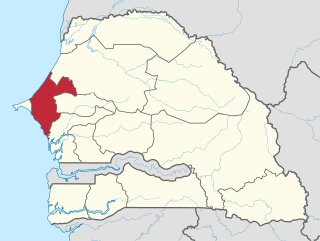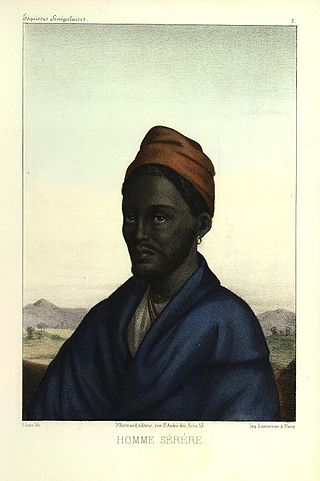Population
In 2003, the local population was estimated to be 2889 with 327 houses. [3]
Djilas (also spelled Djilass or Djilasse) is a village in Senegal located in the Sine-Saloum, in the west.
It is the chef-lieu of the rural community of Djilas, [1] located in the Fimela Arrondissement, of the Fatick Department and the Region of Fatick.
Djilas is situated in the ancient Kingdom of Sine, one of the precolonial kingdoms of the Serer people. In precolonial times, the Thilas - a Serer title of nobility took residence at Djilas. [2]
In 2003, the local population was estimated to be 2889 with 327 houses. [3]

Thiès is a region of western Senegal. The capital is also called Thiès.

Fatick is the southwest region of the northern outcrop of Senegal. Its alternative name is Jinnak Bolon. The region is named for its capital city, Fatick.

Fatick department is one of the 46 departments of Senegal, one of the three departments making up the Fatick region, and lies on the road between Mbour and Kaolack. The Fatick region is home to many Sereer people ; the Sereers are one of the major ethnic groups in Senegal and there are four Sereer dialects. At least 99% of the regional area consists Seereer, notably of Seereer Niominka people, and less than 1% of migrant Fulbe.

The Kingdom of Sine was a post-classical Serer kingdom along the north bank of the Saloum River delta in modern Senegal.
Sine-Saloum is a region in Senegal located north of the Gambia and south of the Petite Côte. It encompasses an area of 24,000 square kilometers, about 12% of Senegal, with a population in the 1990s of 1,060,000.
Fatick is a town and urban commune in Senegal, located between M'bour and Kaolack and inhabited by the Serer people. Its 2023 population was at 39,361. It is the capital of the Fatick Region and the Fatick Department.

Diakhao Arrondissement is an arrondissement of the Fatick Department in the Fatick Region of Senegal. Its capital is Diakhao.
Palmarin is a coastal village in Senegal, located in Sine-Saloum near Sangomar Point between Joal-Fadiouth and Djifer.
The French conquest of Senegal started in 1659 with the establishment of Saint-Louis, Senegal, followed by the French capture of the island of Gorée from the Dutch in 1677, but would only become a full-scale campaign in the 19th century.

The Saltigue, are Serer high priests and priestesses who preside over the religious ceremonies and affairs of the Serer people, such as the Xooy ceremony, the biggest event in the Serer religious calendar. They usually come from ancient Serer paternal families, and the title is inherited by birthright. In Serer country, Saltigue are always diviners.
Fandène is a small village in Senegal about 7 km from Thiès. It is inhabited by the Serer people.

Mbissel is a village in the west of Sénégal. It is situated in the region of Fatick. The population is overrun by the Serer people.
Somb is a town in Senegal situated in the west of the country.
Thiouthioune is a village in Senegal located in the pre-colonial Serer Kingdom of Sine. The current population is estimated at 763. The Battle of Fandane-Thiouthioune commonly known as "the Battle of Somb" took place within the vicinity of this village. In that battle, the Serer strategy - led by their king Maad a Sinig Kumba Ndoffene Famak Joof was to prevent the Muslim marabouts of Senegambia who came to launch jihad from entering Thiouthioune. Initially, the Muslims successfully broke the Serer lines and entered Thiouthioune. However, at the later stages of the battle, the Muslims were defeated by the Serer forces and Serer religion was installed. The leader of the Muslim army was decapitated in that battle under the orders of the Maad a Sinig. The sovereign of Thiouthioune in 1867 was Maad Amad Ngoneh Joof, commonly known as Amad Ngoneh Thiouthioune. He was the paternal uncle of the king of Sine. He and his army also fought in the battle to defeat the Marabouts.
Maad a Sinig Mahecor Joof was the last king to rule the Serer Kingdom of Sine, now part of independent Senegal. Maad a Sinig means king of Sine in the Serer language. He reigned from 1924 until his death in 1969. After his death, the Kingdom of Sine was incorporated into independent Senegal.
Diakhao is a small town and commune in the Fatick Region in the west of Senegal.

Thilas was an ancient title of nobility used in the Serer pre-colonial Kingdoms of Sine, Saloum and previously the Kingdom of Baol, which are all now part of modern-day Senegal. The Thilas was the second in the order of succession to the throne after the Buumi who was the heir apparent. Only members of the royal family could hold this title. When a Maad a Sinig dies without a Buumi, the Thilas could ascend the throne at the discretion of the Great Jaraff and his Noble Council of Electors responsible for electing the kings from the royal family. In the history of Sine to its 20th century history, such an incident is only known to have occurred once, at the succession of Maad a Sinig Kumba Ndoffene Fa Ndeb Joof whose predecessor died without a Buumi.
Loul Sessène is a village in Senegal located in the Sine-Saloum area, in the West of the country.

The Battle of Logandème was an uprising led by the Serer King Maad a Sinig Kumba Ndoffene Famak Joof, king of Sine, against the French Empire. The battle took place at Logandème which was a part of Sine at the time. The battle was also a revenge attack against the Serer people after their resounding victory against France at the Battle of Djilass on 13 May 1859. It was the first time that France decided to employ cannonball in the Senegambia.
Tattaguine is a town in the west of Senegal. It is also the name of the rural community.